ECS A85F2-A Golden Review: All That Glitters
by Ian Cutress on January 12, 2013 11:30 AM EST- Posted in
- Motherboards
- ECS
- FM2
- A85X
Rightmark Audio Analyzer 6.2.5
In part due to reader requests, we are pleased to include Rightmark Audio Analyzer results in our benchmark suite. The premise behind Rightmark:AA is to test the input and output of the audio system to determine noise levels, range, harmonic distortion, stereo crosstalk and so forth. Rightmark:AA should indicate how well the sound system is built and isolated from electrical interference (either internally or externally). For this test we connect the Line Out to the Line In using a short six inch 3.5mm to 3.5mm high-quality jack, turn the OS volume to 100%, and run the Rightmark default test suite at 48 kHz, 96 kHz and 192 kHz. We look specifically at the Dynamic Range of the audio codec used on board, as well as the Total Harmonic Distortion + Noise.
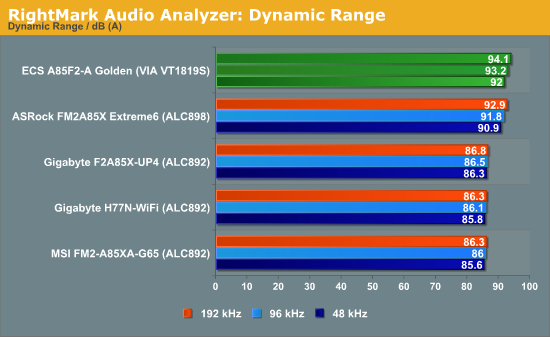
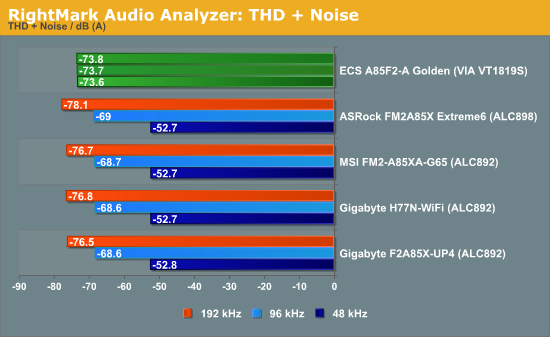
The VIA audio codec was a complete unknown before this review in terms of our RMAA testing, but in terms of dynamic range it seems to beat the Realtek ALC898 hands down. Our THD+N result seems a little strange, however another board recently on my test bed with the Creative Core3D also shows similar behavior.
USB 3.0 Backup
For this benchmark, we run CrystalDiskMark to determine the ideal sequential read and write speeds for the USB port using our 240 GB OCZ Vertex3 SSD with a SATA 6 Gbps to USB 3.0 converter. Then we transfer a set size of files from the SSD to the USB drive using DiskBench, which monitors the time taken to transfer. The files transferred are a 1.52 GB set of 2867 files across 320 folders – 95% of these files are small typical website files, and the rest (90% of the size) are the videos used in the WinRAR test.

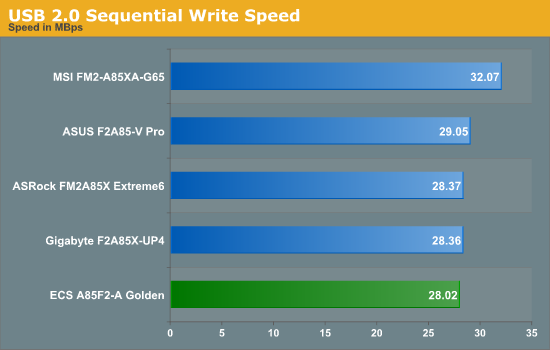

Despite the sequential tests for USB 2.0 being on the low side, our copy test on the ECS performs middle of the pack. Nothing is beating the MSI however.
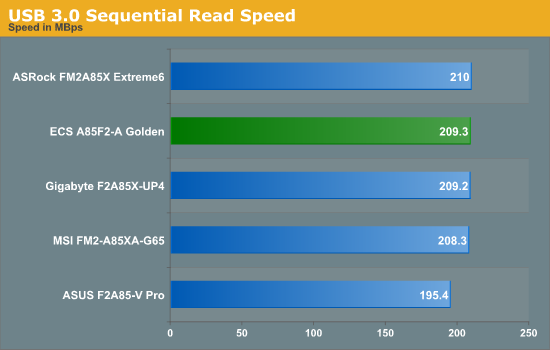
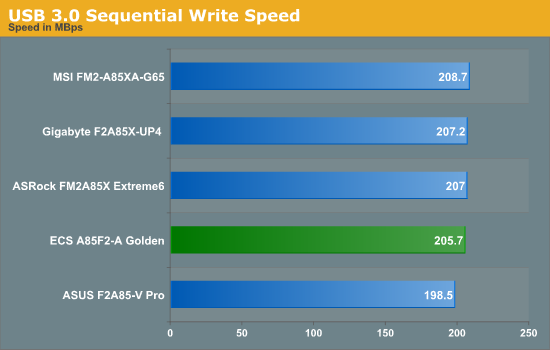
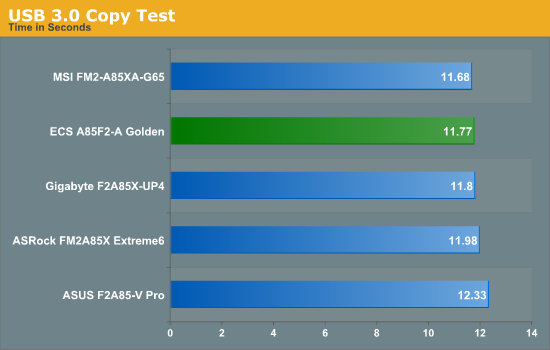
Similarly for our USB 3.0 testing, the ECS A85F2-A Golden performs around the middle, never coming last but never coming first either.
DPC Latency
Deferred Procedure Call latency is a way in which Windows handles interrupt servicing. In order to wait for a processor to acknowledge the request, the system will queue all interrupt requests by priority. Critical interrupts will be handled as soon as possible, whereas lesser priority requests, such as audio, will be further down the line. So if the audio device requires data, it will have to wait until the request is processed before the buffer is filled. If the device drivers of higher priority components in a system are poorly implemented, this can cause delays in request scheduling and process time, resulting in an empty audio buffer – this leads to characteristic audible pauses, pops and clicks. Having a bigger buffer and correctly implemented system drivers obviously helps in this regard. The DPC latency checker measures how much time is processing DPCs from driver invocation – the lower the value will result in better audio transfer at smaller buffer sizes. Results are measured in microseconds and taken as the peak latency while cycling through a series of short HD videos - under 500 microseconds usually gets the green light, but the lower the better.
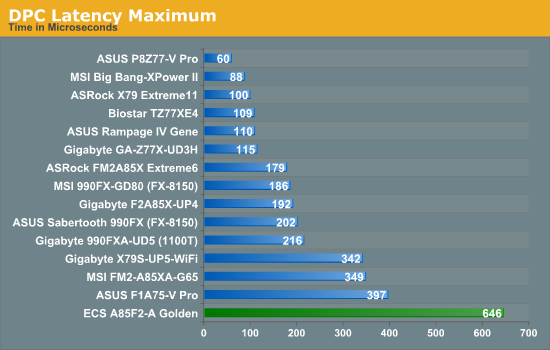
The ECS had a rather large problem with DPC Latency, whereby it would hover around the 200 microsecond mark, before jumping up to 500+ microseconds. Even with all the ECS software disabled, this result continued. A bad DPC Latency test is usually indicative of commands in the DPC queue having higher priority jumping in front of those issued by the program. In the case of time sensitive recording, if this happens regularly, this could be a major issue.










40 Comments
View All Comments
ForeverAlone - Sunday, January 13, 2013 - link
Why so much power and so many slots/plugs on such an underpowered chipset?You'll never need to crossfire/SLI graphics cards with a CPU as weak as the A10-5800K.
Oscarcharliezulu - Sunday, January 13, 2013 - link
This has got to be the most poorly penned review I've read in a while. I reads mostly like a cut and paste jumble. You repeat yourself constantly. The grammar makes my brain hurt. Your assumptions about what "golden" represents is just space filler. For a moment I thought I was reading a bad auto-translate. Lastly, admitting you look around the web at other opinions and I now am not sure if this review is your opinion or some kind of reference to what other people have said. Please do over. D-.IanCutress - Sunday, January 13, 2013 - link
I do admit that sometimes my British idiosyncrasies come through more on some reviews than others, but it's not something I should apologize for. It did get a thorough triple check before going live, as do all my reviews. If there is something that completely boggles the mind, please feel free to email me for clarification.Regarding space filler, my review is meant to cater for a large percentage of the potential readership, and thus explaining design philosophy to those not accustomed to it is part of the package.
As for looking at other reviews and such, I would be a poor academic researcher if I did not find reference and justification for the results and final opinions of the board. To go in blind would be completely remiss, especially if I come across a fringe issue, or fail to come across a significant issue because I do not specifically test for it. I am a strong advocate in researching a topic before discussing it, especially in such a public facing publication such as AnandTech.
Ian
JonnyDough - Sunday, January 13, 2013 - link
This is actually one of the sharpest boards I have ever seen. As for the gold coated rear ports, I'm not sure if those are necessary, but if the price is right I wouldn't be complaining. Very ooglable! :)lordcheeto - Monday, January 14, 2013 - link
You should review the Biostar Hi-Fi A85W. That's what I have, and it looks good and performs good. Not sure how it stacks up against the boards you have tested, but I think it will do well.http://www.newegg.com/Product/Product.aspx?Item=N8...
sudz - Monday, January 14, 2013 - link
(though on a board this side I would prefer at least five).This size?
Rick83 - Monday, January 14, 2013 - link
out of the box?Back in the Athlon days, main board makers were using this trick to gain a few points in benchmarks, but thankfully it gradually disappeared again.
Now many different main boards hit the market, that overclock CPUs out of the box. This is not acceptable in my book, as I want all components in my system to play fair with one another, and adhere to the well known specs.
This kind of fudging around for a few percent of performance in some computation benchmarks, that don't even reflect real world gains, should be harshly judged.
After reading this, I stopped reading the rest of the review.
One other note. As you write scientific articles, why do you not preface your articles with an abstract? I think this would increase reading efficiency. If the main strong and weak points, as well as the verdict can be resumed on the front page, then a lot of time reading non-essential information can be used otherwise.
CeriseCogburn - Monday, January 14, 2013 - link
ECS is plenty big, and has a lot of good boards toward the cheaper end at all levels.The problem here is AMD and it's crap. The overclock page is embarrassing.
Another unstable piece of amd centered junk.
dgingeri - Monday, January 14, 2013 - link
Sorry, after my past experiences, no matter how nice you find this board and no matter how inexpensive it is, I am not ever going to buy ECS hardware. I had a motherboard that was bad out of the box, returned it for warranty replacement, got 3 used ones in a row, including one with the socket lever broken, that were also non-functional over the course of 3 months, and then declared the board was no longer under warranty because it was beyond 90 days. (This was way back in the socket 5 days.) I swore off them then and have never bought another one, in nearly 20 years.Not gonna happen. I won't trust them again.
ggathagan - Monday, January 14, 2013 - link
Not particularly a fan of ECS, but I think 20 years is long enough to hold a grudge.It would be a surprise if 80% of the ECS employees in 1991 are still working there.
:)